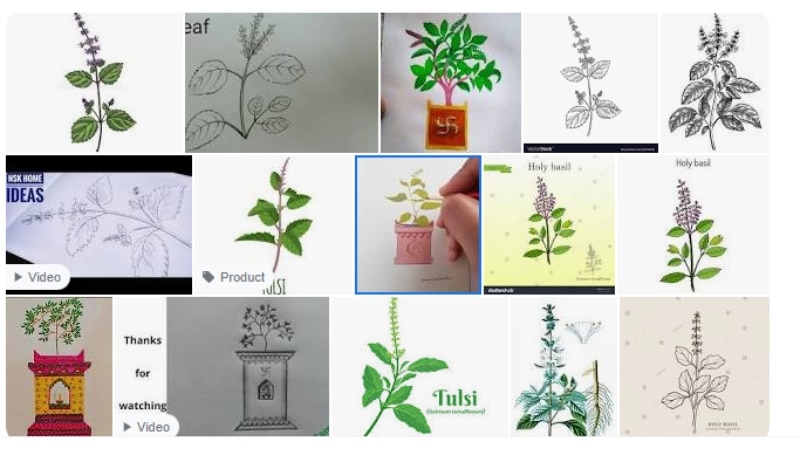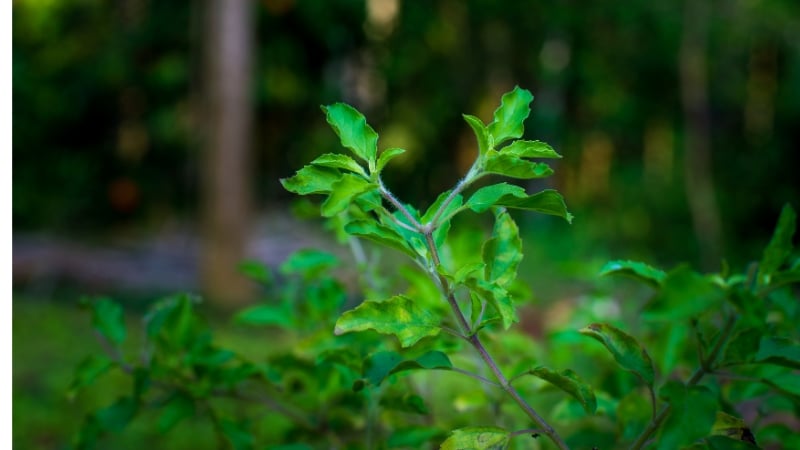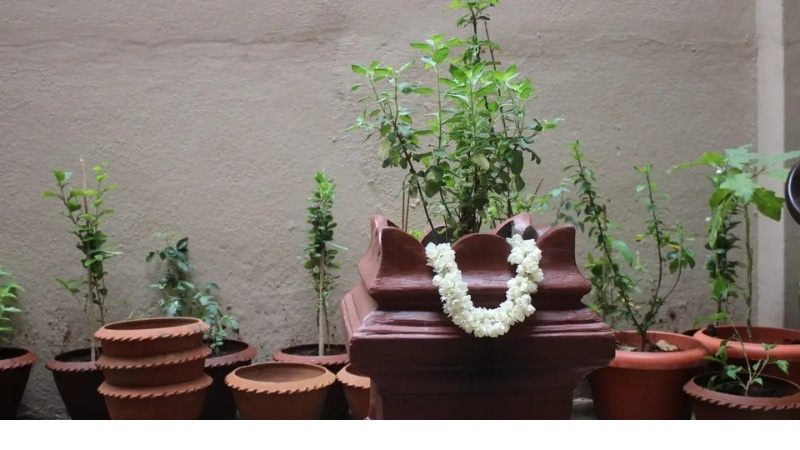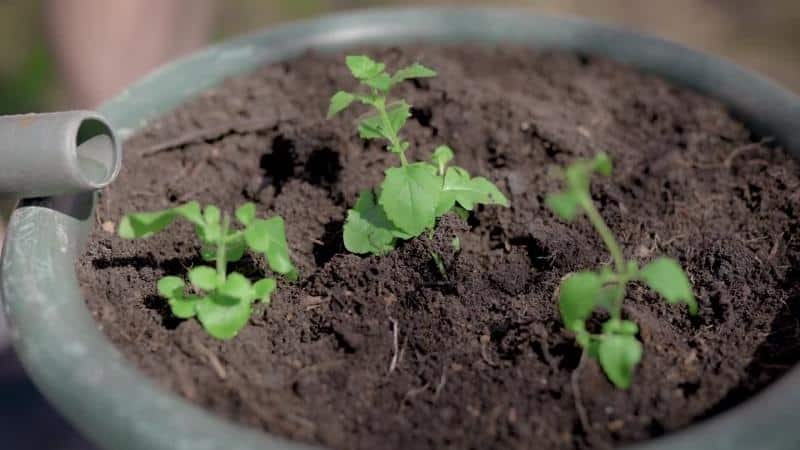The Silver Tulsi Plant is a beautiful and sacred plant with silver-colored leaves often used in religious ceremonies. Known for its medicinal and therapeutic properties, it is highly revered in Hindu culture.
Read More:
Its scientific name is Ocimum tenuiflorum, and it is native to India and Southeast Asia. In addition to its religious and cultural significance, the Silver Tulsi Plant is also valued for its ability to reduce stress, improve digestion, and boost immunity.

With its striking appearance and beneficial properties, this plant is a popular choice for both indoor and outdoor gardens. Whether for spiritual or health reasons, the Silver Tulsi Plant is a valuable addition to any plant collection.
The Spiritual Symbolism Of The Silver Tulsi Plant
The silver Tulsi plant carries deep spiritual symbolism and is believed to bring peace and harmony. Its presence in religious rituals and its ability to purify the environment make it a significant symbol in Hindu culture.
History And Cultural Significance
- The silver Tulsi plant holds great cultural significance in various traditions and religions, including Hinduism.
- It has a long history, tracing back centuries, and is deeply embedded in Indian culture and spirituality.
- The plant is revered as a sacred herb and considered the holiest of all plants.
- It is often grown in households and temples, where it is cared for and worshipped by devotees.
- The Tulsi plant is believed to bring good luck, prosperity, and health to those who nurture and cherish it.
- Its silver variant, with its shiny leaves and delicate appearance, has gained special attention for its aesthetic appeal and spiritual symbolism.

Spiritual Beliefs And Practices Associated With The Plant
- The silver Tulsi plant is believed to possess powerful spiritual properties.
- It is considered a channel for positive energy, purifying the environment and promoting spiritual well-being.
- Many believe that keeping the plant in the house brings spiritual protection and wards off negative energies.
- Devotees often perform daily rituals, such as watering the plant and offering prayers, to show reverence and seek its blessings.
- The plant is also used in Ayurvedic medicine for its various health benefits, both physical and mental.
- The fragrance of its leaves is said to have a calming effect and aid in meditation and spiritual practices.
Connection To Hindu Mythology And Deities
- In Hindu mythology, the Tulsi plant is associated with the goddess Lakshmi, the deity of wealth, prosperity, and beauty.
- It is believed that the goddess resides within the plant, and by worshiping Tulsi, one can attract her blessings.
- The Tulsi plant is also associated with Lord Vishnu, one of the most significant deities in Hinduism.
- According to legends, the plant originated from the tears of his wife, who was transformed into the sacred plant when cursed by a sage.
- The association with Lord Vishnu makes the Tulsi plant even more revered and worthy of devotion.
- Its presence is considered auspicious during religious ceremonies and festivals, symbolizing purity and divine grace.
Remember to optimize the content by using relevant keywords, while maintaining the natural flow and readability of the text.
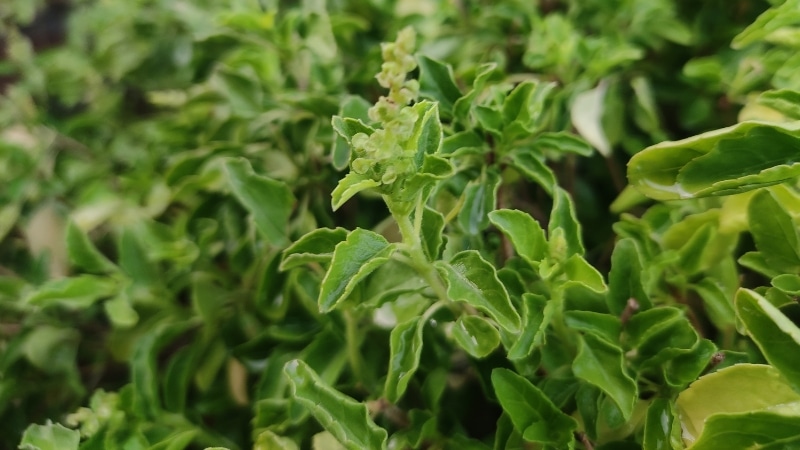
Medicinal Properties Of The Silver Tulsi Plant
The Silver Tulsi plant possesses numerous medicinal properties and is highly revered for its healing abilities. Its leaves are known for their antioxidant, anti-inflammatory, and antimicrobial properties, making it a valuable herb in traditional medicine.
The Silver Tulsi Plant, also known as Tulsi (Ocimum tenuiflorum), is a sacred medicinal herb in Ayurveda, the traditional Indian system of medicine. With its striking silver leaves and potent aromatic scent, this plant has gained popularity not just as an ornamental addition to gardens, but also for its various health benefits.
Let’s explore some of the medicinal properties of the Silver Tulsi Plant.
Traditional Uses In Ayurveda
- Tulsi has been used for centuries in Ayurvedic medicine to treat a wide range of ailments, thanks to its abundant medicinal properties.
- It is considered an adaptogen, which means it helps the body cope with stress and improves overall resilience.
- In Ayurveda, Tulsi is often prescribed for its immune-boosting properties and is believed to promote physical and mental well-being.
- The leaves of the Silver Tulsi Plant are often used in making herbal teas, tonics, and extracts to treat respiratory issues, digestive problems, and skin conditions.

Potential Health Benefits
- The Silver Tulsi Plant possesses strong antibacterial, antifungal, and anti-inflammatory properties, making it an effective natural remedy for common bacterial and fungal infections.
- It is believed to have antioxidant effects that help protect the body against free radicals, reducing the risk of chronic diseases such as heart disease and cancer.
- Tulsi leaves are rich in essential oils, including eugenol, which is known for its analgesic and anti-inflammatory properties, providing relief from pain and inflammation.
- The plant is known to possess neuroprotective properties that may help improve cognitive function and memory.
- Tulsi is also considered a potent antistress herb, supporting the body’s natural response to stress and anxiety.
Scientific Research And Studies
- Various scientific research and studies have been conducted to explore the medicinal properties of the Silver Tulsi Plant.
- Research suggests that Tulsi extracts may have antidiabetic properties, helping to regulate blood sugar levels and enhance insulin secretion.
- Studies have shown that Tulsi leaves possess antimicrobial properties and can inhibit the growth of certain pathogens such as bacteria and fungi.
- Tulsi has been found to have hepatoprotective properties, protecting the liver against damage caused by chemicals and toxins.
- Research also indicates that Tulsi extracts may have anti-cancer potential, as they exhibit cytotoxic effects on cancer cells.
The Silver Tulsi Plant offers a multitude of medicinal properties that have been recognized in Ayurveda for centuries. From its immune-boosting effects to its potential as an antistress herb, Tulsi is a versatile and natural remedy for a range of health issues.
Scientific research and studies continue to shed light on its diverse benefits, making it a promising herb in modern medicine. Incorporating Tulsi into your daily routine may provide you with the wellness support you need to lead a healthier and happier life.
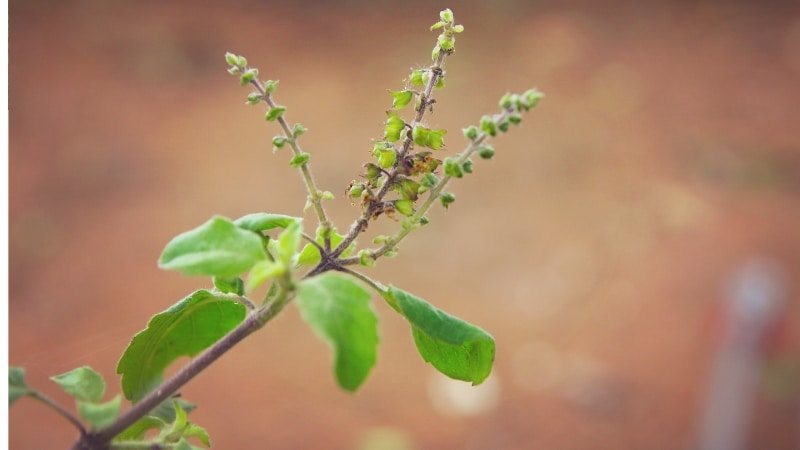
Choosing The Right Location For Your Silver Tulsi Plant
Discover the perfect spot for your Silver Tulsi plant with our helpful guide. Find the ideal location to ensure optimal growth and health for this stunning plant.
Ideal Growing Conditions
- The silver tulsi plant, known for its striking silver foliage, requires specific growing conditions to thrive. Here are the ideal conditions to consider:
- Sunlight: Place your silver tulsi plant in a location that receives ample sunlight. Aim for at least 6-8 hours of direct sunlight daily for optimal growth.
- Temperature: This plant thrives in warm temperatures, ideally between 70-90 degrees Fahrenheit (21-32 degrees Celsius). Avoid exposing it to cold drafts or extreme temperature fluctuations.
- Humidity: Silver tulsi plants prefer moderate humidity levels. If you live in drier climates, consider using a humidifier or placing a tray with water near the plant to increase moisture in the air.
- Soil: Use well-draining soil with a pH level between 6.0 and 7.5. Avoid heavy clay or compacted soils, as they can hinder root development.
- Watering: Water the silver tulsi plant thoroughly when the top inch of soil feels dry. Ensure proper drainage to prevent waterlogged roots, which can lead to rot.
Sunlight And Temperature Requirements
- The silver tulsi plant thrives under specific sunlight and temperature conditions. Here’s what you need to know:
- Sunlight: Choose a location that provides ample sunlight for at least 6-8 hours each day. Place it near a sunny window or in a spot with direct sunlight to ensure proper growth and vibrant foliage.
- Temperature: Maintain a warm environment for the silver tulsi plant, ideally between 70-90 degrees Fahrenheit (21-32 degrees Celsius). Avoid placing it in areas prone to cold drafts or temperature extremes.
Indoor And Outdoor Cultivation Options
- The silver tulsi plant can be cultivated both indoors and outdoors, offering flexibility based on your preferences and available space. Consider the following options:
- Indoor cultivation: If you wish to grow silver tulsi indoors, choose a bright location near a window where it can receive ample sunlight. Ensure proper temperature and humidity levels, and use a well-draining potting mix. Regularly rotate the plant to promote even growth.
- Outdoor cultivation: Silver tulsi plants can thrive outdoors in suitable climates. Find a sunny spot in your garden that meets the plant’s sunlight and temperature requirements. Prepare the soil by incorporating organic matter for improved drainage and nutrient content. Remember to water it regularly and protect it from extreme weather conditions.
The silver tulsi plant’s ideal growing conditions include sufficient sunlight, appropriate temperature, moderate humidity, well-draining soil, and proper watering. Whether you choose to cultivate it indoors or outdoors, providing the right environment will help your silver tulsi plant flourish. Keep these considerations in mind for healthy and thriving plants.
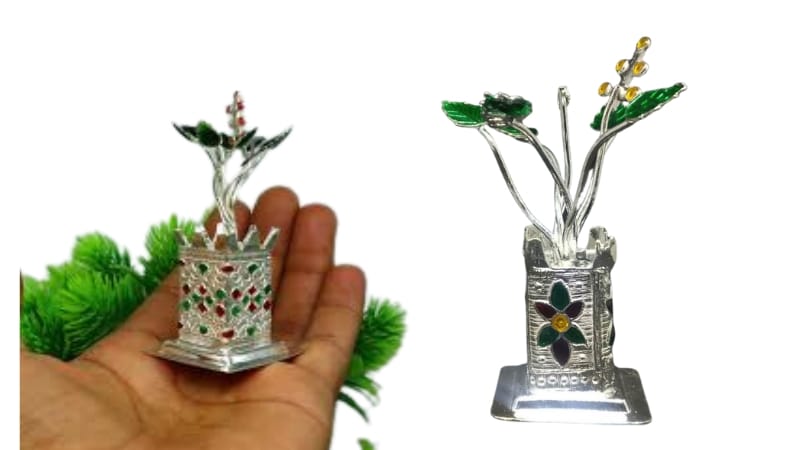
Happy gardening!
Watering And Feeding Your Silver Tulsi Plant
Watering and feeding your silver Tulsi plant is essential for its growth and health. Ensure regular watering, providing enough moisture without overwatering. Feed the plant with organic fertilizer to promote its overall well-being.
Taking care of your silver tulsi plant involves providing it with the right amount of water and nutrients. By understanding proper watering techniques and nutrient requirements, you can ensure the health and vitality of your plant. In this section, we will explore these essential aspects in detail.
Proper Watering Techniques
To maintain the optimal moisture level for your silver tulsi plant, follow these watering techniques:
- Water your plant thoroughly once a week to ensure deep root hydration.
- Check the soil moisture before watering by inserting your finger about an inch deep into the soil. If it feels dry, it’s time to water.
- Avoid overwatering, as excessive moisture can lead to root rot. Make sure the soil has proper drainage to prevent waterlogging.
- During dry spells or hot weather, monitor your plant for signs of dehydration, such as wilting or drooping leaves. In such cases, increase the frequency of watering while maintaining moderation.
- Use room temperature water, preferably filtered or distilled, to avoid exposing your silver tulsi plant to harsh chemicals present in tap water.
Nutrient Requirements
Silver tulsi plants have specific nutrient requirements to thrive. Here are some key points to keep in mind:
- Provide your plant with a balanced fertilizer that contains essential nutrients like nitrogen, phosphorus, and potassium (NPK). This helps promote healthy growth and stronger immunity.
- Ensure the fertilizer has a higher nitrogen content (first number in the NPK ratio) to support foliage development.
- Apply the fertilizer every two to three weeks during the growing season (spring and summer) and reduce the frequency during the dormant period (fall and winter).
- Monitor your plant for any deficiencies, such as yellowing leaves or stunted growth. Adjust the nutrient application accordingly.
- Consider supplementing your plant’s diet with organic amendments like compost or well-decomposed manure. These natural additives improve soil fertility and provide micronutrients essential for overall plant health.
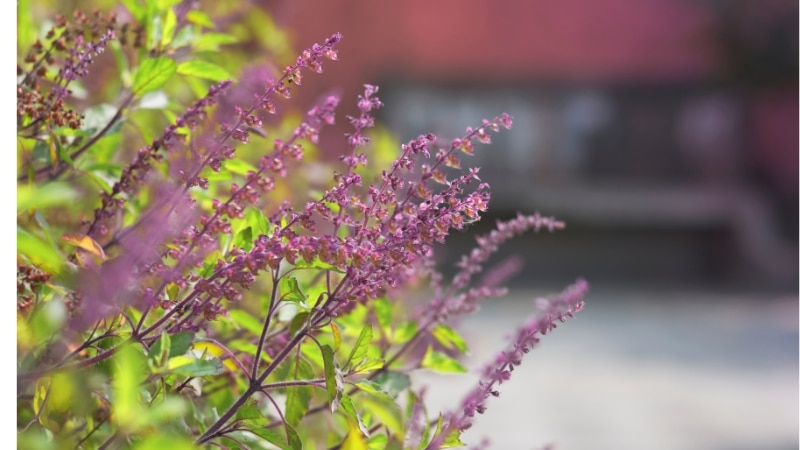
Organic Fertilizers And Supplements
Silver tulsi plants respond well to organic fertilizers and supplements. Here are some options to consider:
- Neem cake: Rich in nutrients, neem cake acts as an excellent soil conditioner while serving as a natural pest repellent.
- Vermicompost: Made from earthworm castings, vermicompost enhances soil structure and enriches it with essential nutrients.
- Seaweed extract: Packed with micronutrients and growth regulators, seaweed extract improves plant vigor and enhances disease resistance.
- Epsom salt: Magnesium sulfate, commonly known as Epsom salt, promotes healthy foliage and enhances nutrient absorption.
Remember, organic fertilizers and supplements should be used in moderation, following the recommended dosage mentioned on the product packaging.
By implementing these watering techniques and providing your silver tulsi plant with the necessary nutrients, you can cultivate a thriving and vibrant plant. Keep in mind the specific requirements of your plant and adjust the care accordingly. Happy gardening!
Pruning And Propagating The Silver Tulsi Plant
Discover the ins and outs of pruning and propagating the Silver Tulsi plant, ensuring healthy growth and abundant foliage. Boost your gardening skills and create a thriving Silver Tulsi garden with these expert tips.
Silver Tulsi Plant:
If you have a silver tulsi plant in your garden, it’s important to understand how to prune and propagate it properly. Pruning helps maintain the plant’s shape and size, while propagation allows you to create new plants. In this section, we will explore techniques for maintaining the plant’s shape and size, as well as different propagation methods for new plants.
Maintaining Plant Shape And Size
To ensure that your silver tulsi plant remains healthy and visually appealing, it’s crucial to maintain its shape and size. Here are some tips to help you achieve this:
- Regularly trim back any overgrown or leggy branches to keep the plant compact and bushy.
- Remove any dead or damaged leaves and stems to promote new growth and prevent the spread of diseases.
- Maintain a balanced shape by selectively pruning branches that disrupt the overall aesthetic of the plant.
- Be mindful of the plant’s natural growth habits and adjust your pruning techniques accordingly.
Techniques For Pruning
Pruning the silver tulsi plant requires proper techniques to ensure optimal results. Here are some techniques you can use:
- Pinching: Pinching involves removing the tip of the stem with your fingers or using pruning shears. This technique encourages the growth of lateral branches and helps maintain a compact shape.
- Thinning: Thinning is the process of removing entire branches or stems from the plant. It helps improve air circulation and reduces the risk of diseases.
- Heading back: Heading back involves cutting back the length of stems to a set point. This technique helps control the plant’s size and shape.
Propagation Methods For New Plants
If you want to expand your silver tulsi plant collection or share it with others, propagation is the way to go. Here are some methods you can use to propagate new plants:
- Stem cuttings: Take 4-6 inch stem cuttings from a healthy silver tulsi plant. Remove the lower leaves and place the cutting in a well-draining potting mix. Keep it moist and warm until roots develop.
- Division: As perennials, silver tulsi plants can be divided to create new plants. Carefully dig up the plant and separate the root clumps, ensuring each division has viable roots and shoots.
- Seeds: Silver tulsi plants produce small seeds that can be collected and sown in a suitable growing medium. Follow the seed packet instructions for optimal germination.
Remember to provide adequate water, light, and care to the newly propagated plants to give them the best chance to thrive.
In pruning and propagating your silver tulsi plant, you not only enhance its appearance but also promote healthier growth and expand your plant collection. With the right techniques and methods, you can maintain your plant’s shape and size while creating new plants to enjoy or share with others.
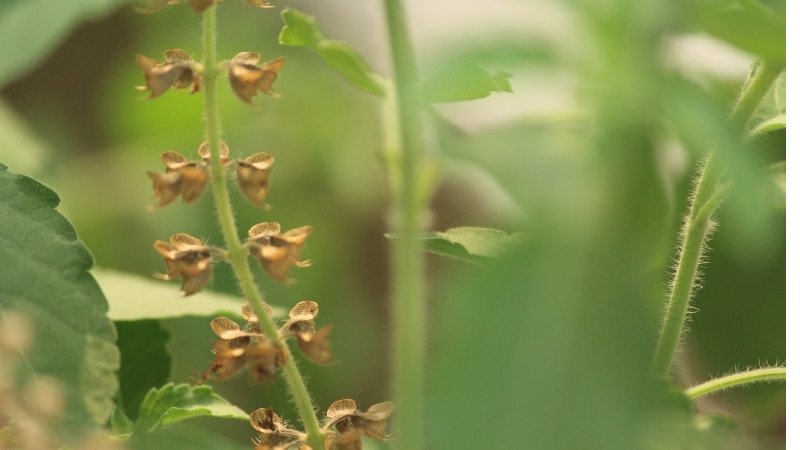
Rama Tulsi: The Holy Basil Of Protection
Discover the protective powers of the Silver Tulsi Plant, also known as Rama Tulsi, revered as a holy basil in Ayurvedic tradition. Its healing properties and revered status make it a must-have addition to any sacred space.
Silver Tulsi Plant:
Discover the fascinating world of the Silver Tulsi Plant, also known as Rama Tulsi, and its incredible significance in Hindu worship. This sacred herb has been revered for centuries due to its numerous traditional uses and benefits. In this blog post, we will delve into its description and characteristics, as well as its significance in Hindu worship.
Additionally, we will explore the various traditional uses and benefits associated with the Silver Tulsi Plant.
Description And Characteristics
The Silver Tulsi Plant, scientifically known as Ocimum sanctum, is a perennial shrub native to the Indian subcontinent. Here are some key features and characteristics of this holy basil plant:
- Appearance: The Silver Tulsi Plant is characterized by its beautiful green leaves with a silvery sheen, which give it its common name. The leaves are slightly larger than those of other Tulsi varieties, measuring around 2 to 4 centimeters in length.
- Fragrance: One of the distinguishing qualities of the Silver Tulsi Plant is its delightful fragrance. When touched or crushed, the leaves emit a powerful and invigorating aroma that is often associated with purification and positivity.
- Adaptability: This variety of Tulsi is known for its adaptability to different climates and growing conditions. It can thrive in both tropical and subtropical regions, making it widely cultivated across various parts of the world.
Significance In Hindu Worship
In Hindu culture, the Tulsi plant holds immense spiritual significance and is considered a sacred symbol of devotion and protection. Here are some key points regarding the significance of the Silver Tulsi Plant in Hindu worship:
- Sacredness: The Silver Tulsi Plant holds a prominent place in Hindu homes, where it is nurtured and worshiped as an embodiment of the divine. It is believed to be the earthly manifestation of the goddess Tulsi, representing purity, divinity, and spiritual growth.
- Protection: Tulsi is revered as a powerful protector against negative energies and evil forces. Its presence in homes is believed to ward off ill omens and bring blessings and positive vibrations to the surroundings. Hindus often plant Tulsi near their entrances for spiritual security and well-being.
- Rituals and Offerings: The Silver Tulsi Plant plays a central role in various Hindu rituals and ceremonies. It is offered daily prayers and flowers as a symbol of reverence and gratitude. The leaves of the Tulsi plant are considered sacred and are used in religious rituals, such as the worship of Lord Vishnu and his avatars.
Traditional Uses And Benefits
The Silver Tulsi Plant offers a multitude of traditional uses and benefits that have been celebrated for generations. Let’s explore some of the most prominent ones:
- Medicinal Properties: This holy basil variety possesses potent medicinal properties. It is believed to have anti-inflammatory, antimicrobial, and antioxidant effects, making it beneficial for various ailments, including respiratory issues, digestive disorders, and skin problems.
- Stress Relief: The aroma of Tulsi leaves is known to have calming and soothing effects on the mind and body. Consuming Tulsi tea or using Tulsi essential oil can help reduce stress, anxiety, and promote overall well-being.
- Enhancing Immunity: Tulsi is revered as an adaptogen, supporting the immune system and helping the body adapt to stressors. Regular consumption of Tulsi leaves or extracts is believed to strengthen the immune system and promote overall health.
The Silver Tulsi Plant, or Rama Tulsi, holds a special place in Hindu culture due to its divine significance and the numerous traditional uses and benefits it offers. From its mesmerizing appearance and enchanting fragrance to its role in Hindu worship and its medicinal properties, this holy basil continues to awe and inspire countless individuals seeking spiritual and physical well-being.
Embrace the blessings of the Silver Tulsi Plant and discover its profound impact on your life.
Krishna Tulsi: The Sacred Basil For Purity
Krishna Tulsi, also known as the Sacred Basil, is a revered plant that symbolizes purity and divine energy. The Silver Tulsi Plant adds a touch of spirituality to any space while promoting overall well-being and a sense of tranquility.
Overview Of The Krishna Tulsi Plant
Krishna Tulsi, also known as the Sacred Basil, is a fascinating plant with a rich history rooted in spirituality and medicinal uses. It is a sacred plant in Hinduism, revered for its various health benefits and abilities to purify the mind, body, and spirit.
Let’s delve into the details of this remarkable herb.

Spiritual And Medicinal Uses
- Krishna Tulsi holds a special place in Hindu religious practices and is considered an incarnation of the Divine on Earth.
- It is believed to remove negative energies, promote positivity, and enhance spiritual well-being.
- This revered herb is used in temples and households for daily worship and religious ceremonies to create a sacred atmosphere.
- Apart from its spiritual significance, Krishna Tulsi is well-known for its medicinal properties.
- The leaves of this plant are rich in essential oils, antioxidants, vitamins, and minerals that boost immunity and restore health.
- It is used to treat various common ailments such as cough, cold, respiratory disorders, digestive issues, and skin problems.
- Krishna Tulsi is known for its adaptogenic properties, which help the body adapt to stress and improve overall resilience.
- The essential oils present in this plant have potent antimicrobial, anti-inflammatory, and analgesic properties, making it beneficial for treating infections and reducing inflammation.
Importance In Ayurvedic Treatments
- Ayurveda, the ancient Indian system of medicine, recognizes Krishna Tulsi as a powerful herb with numerous therapeutic benefits.
- It is considered a vital ingredient in many Ayurvedic formulations due to its ability to balance the three doshas (Vata, Pitta, and Kapha) that regulate the body.
- Krishna Tulsi is used in Ayurvedic treatments like detoxification, rejuvenation, and maintaining overall well-being.
- It acts as an excellent decongestant for the respiratory system, providing relief from allergies, asthma, and bronchitis.
- This sacred herb is also used to promote mental clarity, improve memory, and reduce anxiety and stress.
- Ayurvedic practitioners often prescribe Krishna Tulsi teas, extracts, or essential oils as part of their holistic treatment approach.
Krishna Tulsi, also known as the Sacred Basil, is a highly revered plant in Hindu culture, valued for its spiritual significance and therapeutic properties. Its contributions to spiritual practices, along with its remarkable uses in traditional medicine such as Ayurveda, make it a truly extraordinary herb deserving of recognition and respect.
Setting Up A Sacred Space For Your Silver Tulsi Plant
Create a sacred space for your silver Tulsi plant to cultivate positive energy and sacredness. Provide a serene environment by choosing a specific location, arranging meaningful decorations, and setting intentions for your plant’s growth and well-being.
Creating an altar or shrine:
- Choose a dedicated space in your home or garden where you can set up a beautiful altar or shrine for your silver Tulsi plant.
- Find a small table or shelf that can hold the plant and any sacred objects you’d like to include.
- Place a clean cloth or mat on the surface to create a soft foundation for your sacred space.
- Arrange your silver Tulsi plant at the center of the altar, ensuring it is positioned prominently.
- Surround the plant with meaningful objects such as crystals, prayer beads, incense, or statues of deities that hold significance to you.
- Consider adding candles or a small water feature to enhance the ambiance of your sacred space.
- Take time to regularly clean and tidy your altar, keeping it a sacred and respectful place of devotion.

Sacred rituals and practices:
- Engage in daily rituals and practices that honor the presence of your silver Tulsi plant.
- Begin each day by offering water to the plant as a symbol of respect and gratitude.
- Light incense or a candle and say a prayer or chant that aligns with your spiritual beliefs.
- Throughout the day, pause for a moment of reflection and presence in the presence of the plant.
- Create a ritual of watering the plant, nourishing it both physically and energetically.
- Take time to observe and appreciate the growth and transformation of your silver Tulsi plant, recognizing its sacred nature.
Incorporating the plant in meditation and prayer:
- Find a comfortable space near your silver Tulsi plant where you can sit and meditate.
- Close your eyes and take deep breaths, allowing yourself to relax and enter a state of calm.
- Visualize the energy of the plant flowing through you, filling you with its healing properties.
- Incorporate the scent of the plant, its leaves, or its essential oil into your meditation practice.
- Use the presence of the silver Tulsi plant as a focal point for your prayers, directing your intentions and gratitude towards it.
- Allow the plant to serve as a reminder of the interconnectedness of all living beings, fostering a sense of unity and compassion in your spiritual practice.
By setting up a dedicated sacred space for your silver Tulsi plant, engaging in sacred rituals and practices, and incorporating the plant into your meditation and prayer, you can deepen your connection to the divine and create a haven of spirituality in your home or garden.
Embrace the opportunity to honor and nurture this sacred plant, and let it guide you on a path of spiritual growth and enlightenment.
Harnessing The Mystical Powers Of The Silver Tulsi Plant
The Silver Tulsi Plant is a powerful source of mystical energy, known for its spiritual significance and healing properties. With its shimmering foliage and sacred aura, it is revered for bringing blessings and positive vibrations into homes and lives. Discover the enchanting world of the Silver Tulsi Plant and harness its extraordinary powers.
The Silver Tulsi Plant, also known as the Holy Basil, is not only a beautiful addition to your home decor but also holds several mystical powers that can enhance your spiritual journey. In this section, we will explore the various ways in which the Silver Tulsi Plant can be harnessed to connect with divine energy, techniques for spiritual healing and protection, and its abilities to enhance mindfulness and inner peace.
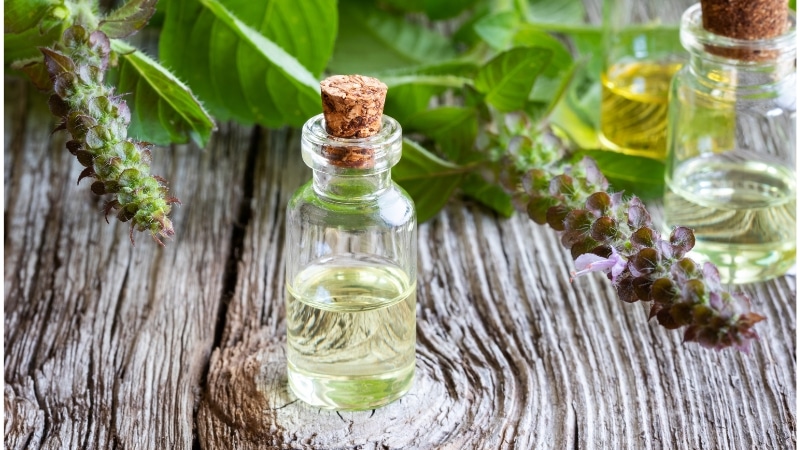
Connecting With Divine Energy:
- Placing the Silver Tulsi Plant in your meditation space or sacred altar can create a strong link with divine energy.
- By offering prayers and chants to the plant, you can enhance your spiritual connection and experience a deeper sense of tranquility.
- The plant’s vibrant silver color is said to attract positive energy and facilitate a harmonious flow of cosmic forces.
- The leaves of the Silver Tulsi Plant are believed to possess strong purifying properties, helping to cleanse the aura and create a sacred environment.
Techniques For Spiritual Healing And Protection:
- The Silver Tulsi Plant emits a subtle fragrance that is known to have healing properties. Inhaling this aroma can alleviate stress and promote emotional well-being.
- Placing the plant near the entrance of your home is believed to ward off negative energies and protect your space from evil spirits.
- Consuming the leaves of the Silver Tulsi Plant in the form of tea or tinctures can aid in detoxifying the body, boosting the immune system, and balancing energy levels.
- The plant is often used in Ayurvedic medicine for its anti-inflammatory and antibacterial properties, making it a valuable tool for physical and spiritual healing.
Enhancing Mindfulness And Inner Peace:
- By cultivating and caring for the Silver Tulsi Plant, you develop a deeper sense of mindfulness and connection with nature.
- The act of nurturing the plant can serve as a meditative practice, allowing you to focus on the present moment and find inner peace.
- Spending time in the presence of the Silver Tulsi Plant can help reduce anxiety, promote relaxation, and enhance overall well-being.
- The plant’s calming energy can support your spiritual journey and encourage self-reflection and personal growth.
Harnessing the mystical powers of the Silver Tulsi Plant can be a transformative experience, connecting you with divine energy, offering spiritual healing and protection, and enhancing mindfulness and inner peace. By integrating this sacred plant into your daily rituals and practices, you can unlock its full potential and embark on a deeper spiritual journey.
last massage
The silver tulsi plant is more than just a decorative addition to your garden. With its rich history and cultural significance, this unique plant is believed to bring good health, happiness, and prosperity. Not only is the silver tulsi plant aesthetically pleasing, but it also offers numerous health benefits, such as boosting immunity, reducing stress, and treating respiratory ailments.
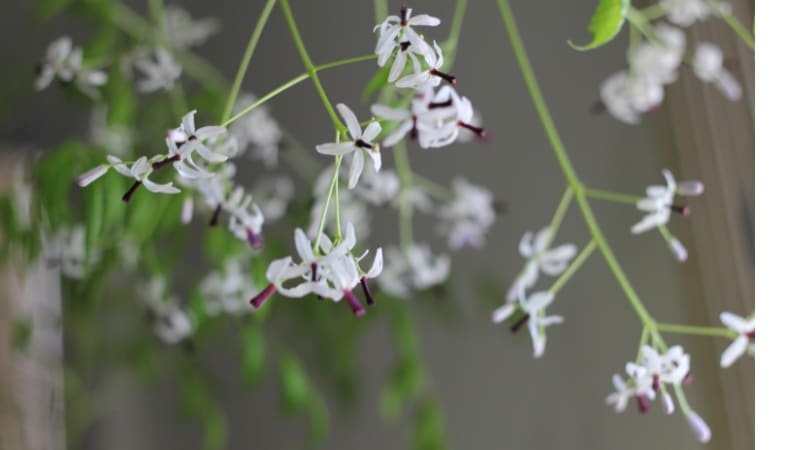
Its silver-toned leaves add a touch of elegance to any space while serving as a natural insect repellent. Whether you choose to worship it or simply enjoy its beauty, the silver tulsi plant is a valuable addition to any home.
By nurturing and caring for this sacred plant, you not only contribute to its preservation but also become a part of a centuries-old tradition. So, why not invite the silver tulsi plant into your life and experience its countless blessings for yourself?

